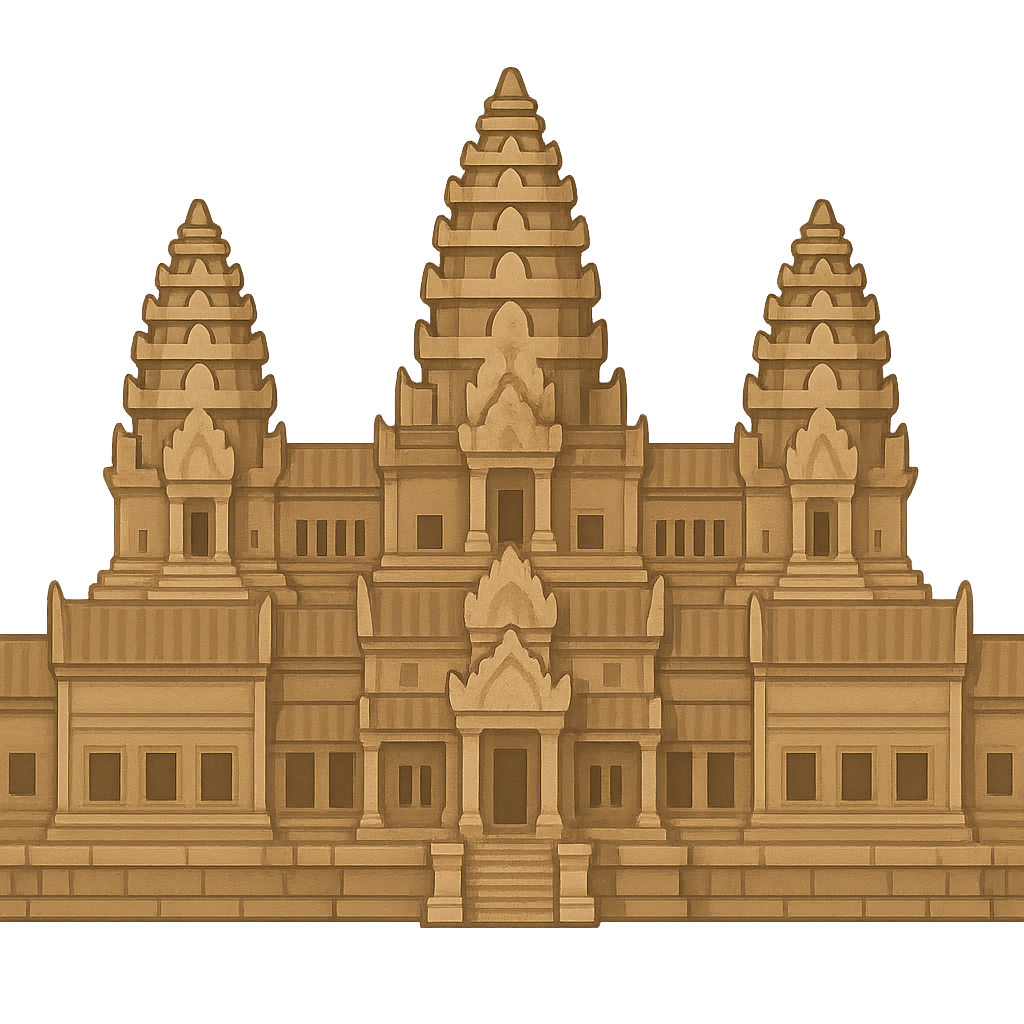The Stone Heart of Cambodia
Before the sun wakes the world, my stone walls are cool and silent, holding the night’s chill. I stand in the heart of a great green jungle, a kingdom of stone surrounded by a vast, shimmering moat that mirrors the sky. As the first light of dawn touches my highest towers, they glow like five giant lotus buds reaching for heaven. The air fills with the chatter of monkeys and the songs of exotic birds; they are my oldest companions. If you walk my long causeways and enter my galleries, you will see that nearly every surface is alive with stories carved in stone. Armies march, graceful dancers curve their hands, and gods and demons battle for control of the cosmos. For centuries, I have stood here, a testament to faith, artistry, and the power of a king’s dream. I am a temple, a city, and a wonder of the world. I am Angkor Wat.
My story begins with a visionary king named Suryavarman II, who ruled the mighty Khmer Empire. He ascended to the throne around the year 1113 CE, and his ambition was as grand as his kingdom. He dreamed of creating a masterpiece that would be both a sacred home for the Hindu god Vishnu and a magnificent final resting place for himself. His vision was not just for a temple, but for a miniature universe on Earth, perfectly aligned with the stars. To bring me to life, an incredible effort began. Millions of heavy sandstone blocks, each one weighing as much as a small elephant, were quarried from the holy mountain of Phnom Kulen, more than 50 kilometers away. These blocks were then floated down rivers and canals on huge rafts to my construction site. For nearly 40 years, thousands of people worked under the tropical sun. Skilled artists covered my walls with intricate bas-reliefs, carving epic tales from Hindu mythology, like the famous “Churning of the Ocean of Milk.” Brilliant engineers designed my complex system of moats and reservoirs, not just for beauty, but to stabilize my massive foundation in the wet, sandy ground. I was built as a symbol of divine power and human devotion, a stone mountain rising from the plains.
For centuries, I was the vibrant heart of the Khmer Empire, a center for Hindu worship where priests performed ceremonies in my sacred chambers. But time brings change, and the beliefs of a people can evolve like a flowing river. By the 14th and 15th centuries, a new faith, Theravada Buddhism, had spread across the land. I watched as saffron-robed Buddhist monks began to walk my corridors. Their peaceful chants echoed where Hindu prayers once did. I was not forgotten or left behind; I was adapted. My purpose was transformed, and I became one of the most important centers for Buddhist learning and pilgrimage in Southeast Asia. Around 1431, the capital of the Khmer Empire moved away from the city of Angkor, and the jungle, which had always been waiting at my edges, began to creep back. Giant tree roots snaked over my walls and galleries, wrapping me in a green embrace. Yet, I was never truly abandoned. The monks remained, tending to my stones and keeping my spirit alive through the quiet centuries.
While the monks and local people always knew of my grandeur, my story was a secret kept by the jungle for much of the outside world. That began to change in the 1860s, when a French naturalist and explorer named Henri Mouhot journeyed through Cambodia. He was stunned by what he saw, writing in his journals about my magnificent towers and breathtaking artistry. His published accounts sparked immense curiosity in Europe and beyond. Suddenly, the world wanted to know about the lost city in the jungle. Archaeologists and historians began the painstaking work of clearing the encroaching vegetation and studying my construction. In 1992, I was named a UNESCO World Heritage site, recognized as a treasure belonging to all of humanity. Today, I am the proud heart of Cambodia, a symbol of national identity that appears on its flag. Visitors from every corner of the globe walk my halls, their footsteps echoing alongside the ghosts of kings, priests, and monks. I stand as a lesson that what humans create with vision and spirit can endure, inspire, and connect us all to a magnificent past.
Reading Comprehension Questions
Click to see answer
